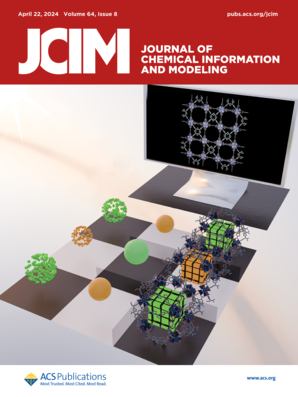C基和g基DNA: A-、B-和Z-DNA及其相关错配三核苷酸重复序列的弯曲自由能比较研究。
IF 5.6
2区 化学
Q1 CHEMISTRY, MEDICINAL
引用次数: 0
摘要
DNA结构的灵活性在基因复制、修复、调控以及DNA-蛋白识别等多种生物学功能中起着至关重要的作用。我们利用定向四元数和增强采样方法研究了DNA短螺旋的弯曲自由能,包括A-, B-和z -型的d(5'-(CG)7C-3')2,以及富含C和g的三核苷酸重复螺旋。定向四元数技术提供了一种有效的方法来诱导旋转变换或抑制生物分子体系的某些结构域的定向。该方法在AMBER模拟包中实现,并用于以两种不同的方式诱导DNA弯曲:自由弯曲和定向弯曲。我们发现弯曲自由能在适度弯曲时呈二次变化,而在较大弯曲角度时则几乎呈线性变化。发现左旋Z-DNA螺旋在研究的典型DNA形式中具有最高的刚性。与弯曲相关的机制也进行了研究,根据顺序和考虑的螺旋形式,研究了I型和II型扭结的证据。在CC和GG错配的情况下,双链具有很高的灵活性,特别是在z形式的CGG和GGC三核苷酸重复中,它们具有最低的弯曲自由能。这些计算通过量化能量成本和弯曲的首选方向,为DNA分子的整体构象灵活性的机制提供了新的见解。本文章由计算机程序翻译,如有差异,请以英文原文为准。
Comparative Study of the Bending Free Energies of C- and G-Based DNA: A-, B-, and Z-DNA and Associated Mismatched Trinucleotide Repeats.
DNA's structural flexibility plays a crucial role in various biological functions such as gene replication, repair, and regulation as well as DNA-protein recognition. We investigate the bending free energy of short DNA helices, including d(5'-(CG)7C-3')2 in A-, B-, and Z-forms, and C- and G-rich trinucleotide repeat helices, using orientation quaternions with enhanced sampling methods. The orientation quaternion technique provides an effective method to induce rotational transformations or to restrain the orientation of certain domains of biomolecular systems. This methodology was implemented in the AMBER simulation package and used to induce DNA bending in two separate ways: free bending and directional bending. We found that the bending free energy varies quadratically for moderate bending and then becomes almost linear for larger bending angles. The left-handed Z-DNA helix was found to exhibit the highest rigidity among the canonical DNA forms studied. The mechanisms associated with bending were also investigated with evidence for type I and type II kinks depending on the sequence and the helical form considered. The duplexes exhibit high flexibility in the presence of CC and GG mismatches, particularly CGG and GGC trinucleotide repeats in the Z-form, which have the lowest bending free energies. These calculations provide new insight into the mechanics of the global conformational flexibility of DNA molecules by quantifying the energetic cost and preferred directions of bending.
求助全文
通过发布文献求助,成功后即可免费获取论文全文。
去求助
来源期刊
CiteScore
9.80
自引率
10.70%
发文量
529
审稿时长
1.4 months
期刊介绍:
The Journal of Chemical Information and Modeling publishes papers reporting new methodology and/or important applications in the fields of chemical informatics and molecular modeling. Specific topics include the representation and computer-based searching of chemical databases, molecular modeling, computer-aided molecular design of new materials, catalysts, or ligands, development of new computational methods or efficient algorithms for chemical software, and biopharmaceutical chemistry including analyses of biological activity and other issues related to drug discovery.
Astute chemists, computer scientists, and information specialists look to this monthly’s insightful research studies, programming innovations, and software reviews to keep current with advances in this integral, multidisciplinary field.
As a subscriber you’ll stay abreast of database search systems, use of graph theory in chemical problems, substructure search systems, pattern recognition and clustering, analysis of chemical and physical data, molecular modeling, graphics and natural language interfaces, bibliometric and citation analysis, and synthesis design and reactions databases.

 求助内容:
求助内容: 应助结果提醒方式:
应助结果提醒方式:


